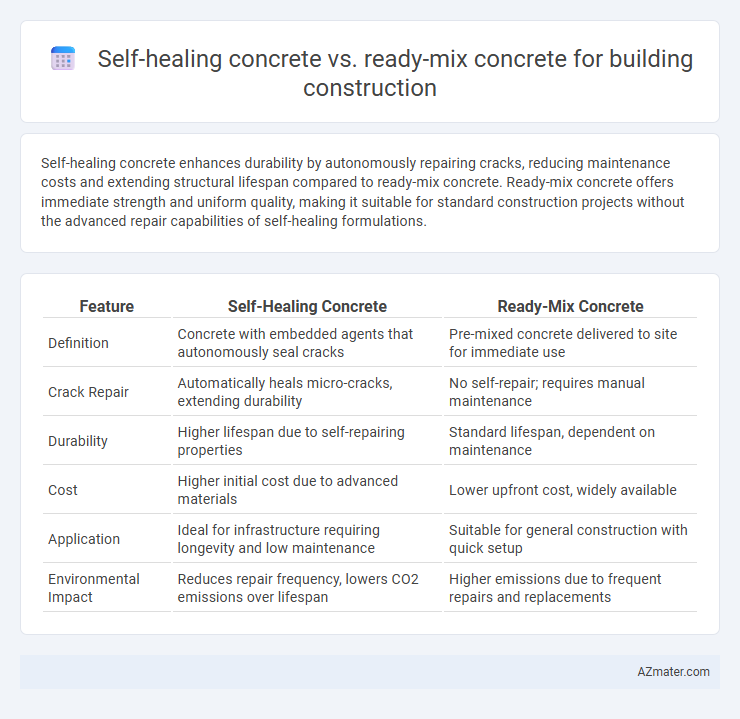Self-healing concrete enhances durability by autonomously repairing cracks, reducing maintenance costs and extending structural lifespan compared to ready-mix concrete. Ready-mix concrete offers immediate strength and uniform quality, making it suitable for standard construction projects without the advanced repair capabilities of self-healing formulations.
Table of Comparison
| Feature | Self-Healing Concrete | Ready-Mix Concrete |
|---|---|---|
| Definition | Concrete with embedded agents that autonomously seal cracks | Pre-mixed concrete delivered to site for immediate use |
| Crack Repair | Automatically heals micro-cracks, extending durability | No self-repair; requires manual maintenance |
| Durability | Higher lifespan due to self-repairing properties | Standard lifespan, dependent on maintenance |
| Cost | Higher initial cost due to advanced materials | Lower upfront cost, widely available |
| Application | Ideal for infrastructure requiring longevity and low maintenance | Suitable for general construction with quick setup |
| Environmental Impact | Reduces repair frequency, lowers CO2 emissions over lifespan | Higher emissions due to frequent repairs and replacements |
Introduction to Concrete Technologies in Modern Construction
Self-healing concrete incorporates microcapsules or bacteria that activate upon cracking to autonomously repair damage, enhancing durability and reducing maintenance costs in modern construction. Ready-mix concrete, produced in controlled batching plants, offers consistent quality and efficient onsite application, supporting large-scale building projects with predictable performance. Both technologies represent advancements in concrete solutions, improving structural longevity and sustainability in contemporary building practices.
Understanding Self-Healing Concrete: How It Works
Self-healing concrete incorporates microcapsules or bacteria that activate upon cracking, releasing healing agents to seal fissures and restore structural integrity, significantly extending the lifespan of buildings. This innovative material contrasts with traditional ready-mix concrete, which lacks autonomous repair mechanisms and requires manual intervention to address damage. The self-repair capability reduces maintenance costs and enhances durability, making it ideal for sustainable building construction.
Ready-Mix Concrete: Composition and Applications
Ready-mix concrete is composed of cement, water, aggregates (sand, gravel, or crushed stone), and admixtures tailored to enhance workability, strength, and durability for various construction projects. It is widely used in building construction due to its consistent quality, efficient delivery, and reduced labor requirements, making it ideal for large-scale applications such as foundations, slabs, beams, and columns. Compared to self-healing concrete, ready-mix concrete lacks autonomous crack repair properties but offers predictable performance and easy integration into conventional construction workflows.
Durability and Longevity: A Comparative Analysis
Self-healing concrete significantly enhances durability and longevity in building construction by autonomously repairing micro-cracks, reducing maintenance costs and extending structural lifespan compared to ready-mix concrete. Ready-mix concrete, while widely used for its uniform quality and convenience, is more susceptible to crack propagation and environmental degradation over time. The incorporation of bacteria or encapsulated healing agents in self-healing concrete improves resistance to water ingress and freeze-thaw cycles, resulting in superior performance under harsh conditions.
Cost Considerations: Self-Healing vs Ready-Mix Concrete
Self-healing concrete involves higher initial costs due to advanced materials and technology integration, but it reduces long-term maintenance and repair expenses significantly by autonomously sealing cracks. Ready-mix concrete offers lower upfront prices with widespread availability, making it cost-effective for immediate construction needs, though it may incur more frequent repair costs over time. Evaluating lifecycle expenses favors self-healing concrete for projects prioritizing durability and reduced maintenance budgets.
Environmental Impact and Sustainability
Self-healing concrete significantly reduces environmental impact by minimizing the need for repairs and extending the lifespan of structures, lowering carbon emissions associated with maintenance and reconstruction. Ready-mix concrete, while efficient for large-scale projects, contributes to high CO2 emissions during cement production and often leads to frequent repairs due to cracking and degradation. Integrating self-healing technology promotes sustainability through decreased material waste and enhanced durability, aligning with green building standards and reducing the overall carbon footprint in construction.
Maintenance Requirements Over Building Lifecycle
Self-healing concrete significantly reduces maintenance requirements over the building lifecycle by autonomously repairing micro-cracks, minimizing deterioration and extending structural durability. Ready-mix concrete typically requires frequent inspections and repairs due to its vulnerability to cracking and environmental stressors. The reduced maintenance frequency of self-healing concrete lowers long-term costs and enhances building sustainability compared to conventional ready-mix concrete.
Structural Performance: Strength and Load-Bearing Capacity
Self-healing concrete enhances structural performance by automatically repairing micro-cracks, thereby maintaining strength and extending load-bearing capacity over time. Ready-mix concrete offers consistent quality and uniformity crucial for immediate structural demands, but lacks the autonomous crack-repair mechanism found in self-healing variants. Incorporating self-healing agents significantly improves durability and long-term resilience compared to traditional ready-mix concrete, especially under dynamic and cyclic loads.
Adoption Challenges and Market Availability
Self-healing concrete offers advanced durability by autonomously repairing micro-cracks, yet its adoption faces challenges including higher material costs, limited large-scale production, and lack of standardized application protocols compared to widely available ready-mix concrete. Ready-mix concrete dominates the construction market due to established supply chains, proven performance, and cost efficiency, but it lacks the intrinsic maintenance benefits of self-healing variants. Market availability of self-healing concrete remains restricted to niche projects and pilot studies, while ready-mix concrete maintains extensive global distribution and immediate accessibility for diverse building construction needs.
Future Prospects: Innovations in Building Construction Materials
Self-healing concrete, embedded with microcapsules or bacteria that autonomously repair cracks, represents a breakthrough in sustainable building technology by significantly extending the lifespan and reducing maintenance costs of structures compared to traditional ready-mix concrete. Innovations such as bacterial mineralization and microvascular networks in self-healing concrete promise enhanced durability, environmental benefits, and cost-efficiency, positioning it as a crucial material for future resilient infrastructure. The growing demand for smart construction materials coupled with advances in nanotechnology and biotechnology solidifies self-healing concrete's role as a transformative solution in next-generation building construction.

Infographic: Self-healing concrete vs Ready-mix concrete for Building construction
 azmater.com
azmater.com